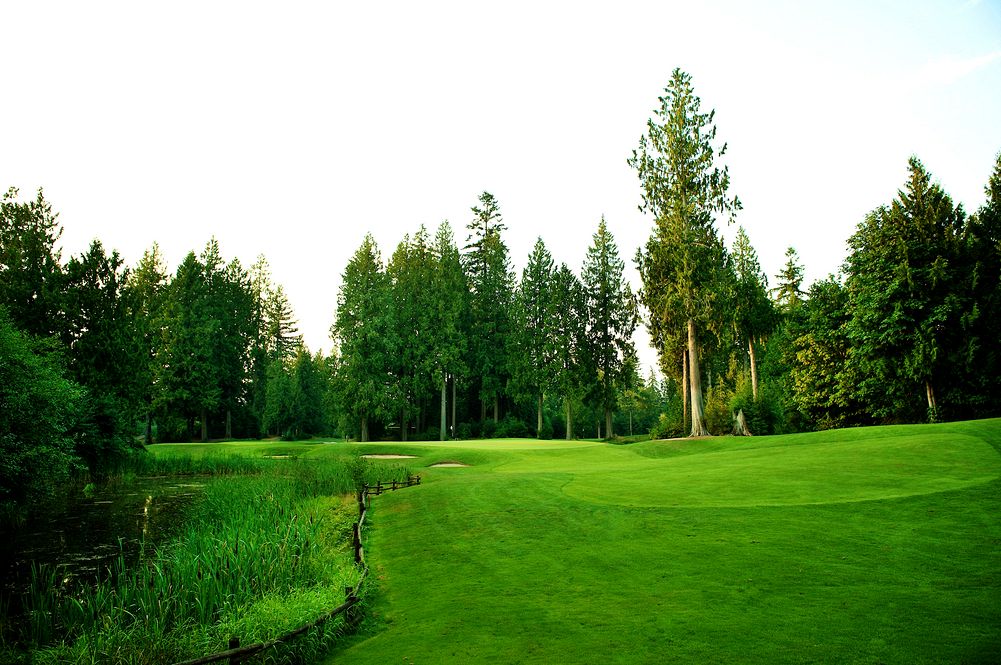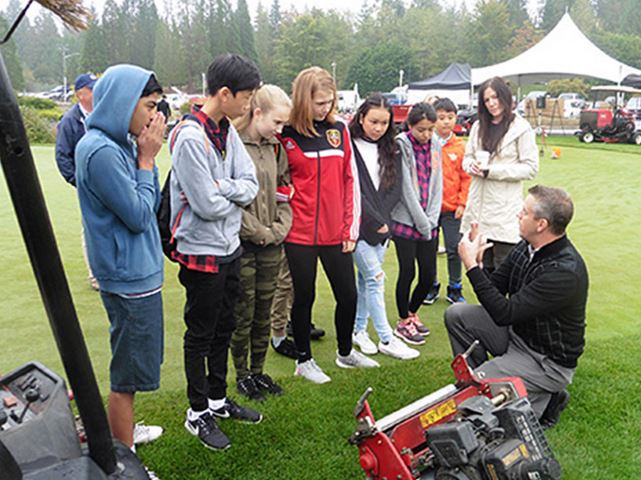March is typically a wet month for us at Redwoods, and this year was definitely no exception! With the arrival of spring, the beautiful blossom of cherry trees, and the emergence of daffodils and tulips, it's hard not to get excited about a new golf season! One of the challenges our
Turfcare Team faces during the changing of the seasons are our limited ability to consistently cut grass--primarily the rough.

Our native soil here at Redwoods is mostly clay, other than greens and tees which are both sand-based. Clay particles are very small and when clay becomes wet it has phenomenal moisture retention capabilities which isn't the most beneficial property to have. When clay becomes saturated it stays that way until the water can drain through, evaporate from the ground, and transpire from the turfgrass plants. This "drying" process can be a little difficult to attain during the West Coast Spring season we are all so used to that often features plenty of rain and cooler temperatures.
When our ground is saturated, any form of surface traffic such as regular footsteps, carts, or mowers, can cause damage to both the soil structure and the turf itself. Our Turfcare Team wants to avoid compacting the soil with the weight of the mowers at all costs. Compaction creates less space within the soil for water and oxygen to move, making it easier for the ground to become saturated with rainwater, and also leaving less space for turfgrass to grow roots. This is our main reason why we don't cut our turf as often when the ground is wet, even if we have a few sunny days in a row; we want to preserve the turf that we have and enable it to flourish during the beginning of the golfing season.
So the next time your foursome is scavenging for their golf balls in the deep rough you can explain the science behind our long grass. Enjoy the Spring golf and try to keep it in the short stuff!
-Your Redwoods Turfcare Team






 It all starts with our Executive Chef, Shane Driediger. Shane got his start washing dishes in a kitchen up in 100 Mile when he was just 13 years old. He eagerly looked forward to the chance to get on to the cooking line and start creating delicious food. At 15, he got that opportunity and proceeded to work at various casual dining restaurants and pubs around the lower mainland while in school working to earn his Red Seal as a Chef. Shane also spent some time travelling and working in places like Club Med in the Bahamas and he even appeared in a cooking show segment on the Outdoor Life Network. Eventually, Shane returned and set down some roots in Langley with a growing catering company and then he finally found his way to Redwoods in 2007. After just one season working at Redwoods, he was promoted to Executive Chef and the rest is history! He is now married, has two awesome kids and is excited to be starting his 10th season at Redwoods!
It all starts with our Executive Chef, Shane Driediger. Shane got his start washing dishes in a kitchen up in 100 Mile when he was just 13 years old. He eagerly looked forward to the chance to get on to the cooking line and start creating delicious food. At 15, he got that opportunity and proceeded to work at various casual dining restaurants and pubs around the lower mainland while in school working to earn his Red Seal as a Chef. Shane also spent some time travelling and working in places like Club Med in the Bahamas and he even appeared in a cooking show segment on the Outdoor Life Network. Eventually, Shane returned and set down some roots in Langley with a growing catering company and then he finally found his way to Redwoods in 2007. After just one season working at Redwoods, he was promoted to Executive Chef and the rest is history! He is now married, has two awesome kids and is excited to be starting his 10th season at Redwoods! Matt is another industry
Matt is another industry  So we have the kitchen taken care of, but who is holding down the fort out front? Well, that would be our towering Restaurant Manager, Tim LaHay, who at 6'5", can always be spotted amongst the crowd. Tim got his start in the industry where so many other restaurant folks do: McDonald's! He got his job at a McDonalds in Aldergrove on the day he turned 15 and has spent his entire 26-year restaurant career working diligently to become a customer service specialist. Having spent time as a manager at a popular Lower Mainland steakhouse, and having played a key role in the evolution of a local start-up casual dining concept as a regional manager, Tim brings a lighthearted but professional approach to ensuring every guest has a memorable time while here for whatever experience brought them through our front doors. 2016 will be Tim's 9th season at Redwoods.
So we have the kitchen taken care of, but who is holding down the fort out front? Well, that would be our towering Restaurant Manager, Tim LaHay, who at 6'5", can always be spotted amongst the crowd. Tim got his start in the industry where so many other restaurant folks do: McDonald's! He got his job at a McDonalds in Aldergrove on the day he turned 15 and has spent his entire 26-year restaurant career working diligently to become a customer service specialist. Having spent time as a manager at a popular Lower Mainland steakhouse, and having played a key role in the evolution of a local start-up casual dining concept as a regional manager, Tim brings a lighthearted but professional approach to ensuring every guest has a memorable time while here for whatever experience brought them through our front doors. 2016 will be Tim's 9th season at Redwoods. rejoining the team after venturing off to get some experience in other areas of the industry. She started with us here in 2010 as a quiet young lady that worked in our snack shack at the 10
rejoining the team after venturing off to get some experience in other areas of the industry. She started with us here in 2010 as a quiet young lady that worked in our snack shack at the 10